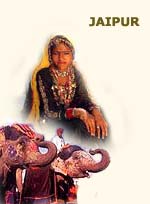 The picturesque capital of Rajasthan, Jaipur is a well planned city with buildings of pink sand stone. It was founded in 1727 A.D. by the astronomer King Sawai Jai Singh – II and built according to shilpashastra. The ancient Hindu treatise on architecture and sculpture. It is a walled city with seven gates. paved roads and the city itself divided into seven rectangular blocks. Amer, the old capital is a fairy tale journey into the past. Jaipur – with its historical past, revives legend of the ancient Rajputs. the dresses of the women and the turbans of the men add colour to this fantasy city.
The picturesque capital of Rajasthan, Jaipur is a well planned city with buildings of pink sand stone. It was founded in 1727 A.D. by the astronomer King Sawai Jai Singh – II and built according to shilpashastra. The ancient Hindu treatise on architecture and sculpture. It is a walled city with seven gates. paved roads and the city itself divided into seven rectangular blocks. Amer, the old capital is a fairy tale journey into the past. Jaipur – with its historical past, revives legend of the ancient Rajputs. the dresses of the women and the turbans of the men add colour to this fantasy city.
There is a timeless appeal to Jaipur’s colorful bazaars where one can shop for Rajasthani handlooms and trinkets. Beautifully laid out gardens and parks, attractive monuments and marvelous heritage hotels, once the residence of Maharaja’s are worth admiration. Not to mention the ambling camels and cheerful people in multi-hued costumes that make your trip to the pink city a memorable one.
PRIME SITES
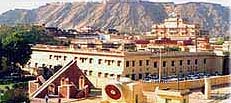 The City Palace : In the heart of the old city is former royal residence built in a blend of the Rajasthani and Mughal styles. The carved arches are supported by grey-white marble columns ornate with floral motifs in gold and colored stones. Two carved elephants in marble guard the entrance. The retainers whose families have served generations of rulers serve as guides.
The City Palace : In the heart of the old city is former royal residence built in a blend of the Rajasthani and Mughal styles. The carved arches are supported by grey-white marble columns ornate with floral motifs in gold and colored stones. Two carved elephants in marble guard the entrance. The retainers whose families have served generations of rulers serve as guides.
The palace houses a museum with a superb collection of Rajasthani costumes and armory of Mughals and Rajputs including swords of different shapes and sizes with chased handles, some of them inlaid with enamel and embellished with jewels and encased in magnificent scabbards.
The palace also has an art gallery with an excellent collection of miniature paintings, carpets, royal paraphernalia and rare astronomical works in Arabic,Persian,Latin and Sanskrit, acquired by Sawai Jai Singh II to study astronomy in detail.
Jantar Mantar: A stone observatory. Largest of Jai Singh’s five remarkable observatories. Its complex instruments,whose setting and shapes are scientifically designed, represent the high points of medieval Indian astronomy.The most striking of these are the Ram Yantras used for gauging altitudes.
Hawa Mahal: Built in 1799 A.D. the Hawa Mahal or Palace of Winds is a major Rajput landmark. This five storey building along the main street of the old city is in pink splendor with semioctagonal and delicately honey combed sandstone windows. The monument was originally conceived with the aim of enabling ladies of the royal household to watch the everyday life and royal processions of the city.
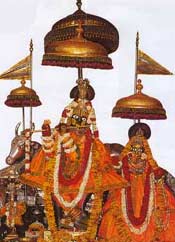 Govind Devji Temple: The most popular spireless temple of Jaipur dedicated to Lord Krishna. It is located in the central pavilion of the Jai Niwas Garden to the north of Chandra Mahal. The image of the patron deity-Govind Devji,originally installed in a temple of Vrindavan, was reinstalled here by Sawai Jai Singh II as his family deity.
Govind Devji Temple: The most popular spireless temple of Jaipur dedicated to Lord Krishna. It is located in the central pavilion of the Jai Niwas Garden to the north of Chandra Mahal. The image of the patron deity-Govind Devji,originally installed in a temple of Vrindavan, was reinstalled here by Sawai Jai Singh II as his family deity.
Ram Niwas Bagh : A lush spacious garden with a zoo, an aviary, a greenhouse, a herbarlum , a museum and popular sport ground. It was built by Sawai Ram Singh II in the 1868 A.D. as a famine relief project. The Albert Hall-fine example of Indo Sarcenic style of architecture designed by Sir Swinton Jacob, was opened later with an exquisite collection of sculptures, paintings, decorative wares, natural history specimen, and Egyptian mummy and the celebrated Persian carpet. Recently, the Rabindra Manch with an auditorium, a modern art gallery and an open air theatre, has been added to promote cultural events.
Dolls Museum : Pretty dolls from various countries are on display in the compound of the school for deaf and dumb children,near the Police Memorial.
BM Birla Planetarium : The Planetarium offers unique audio-visual education and entertainment with its modern computerized projection system. For school groups concessions are available. Closed on last Wednesday of every month.
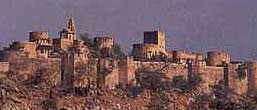 Moti Doongari : Moti Doongari is a privately owned hilltop fort built like a scottish castle. The Ganesh Temple at the foot of the hill
Moti Doongari : Moti Doongari is a privately owned hilltop fort built like a scottish castle. The Ganesh Temple at the foot of the hill
Statue Circle : The full-length exquisitely carve statue of Swai Jai Singh in white marble in the centre of the circle was erected under the newly planned scheme area to pay homage to the founder of Jaipur. OTHERS: Beautiful memorials to the queens,Maharani-ki-chattri are near the Ramgarh road crossing on the Amber Raod. The Island Palace,Jal Mahal built by Sawai Jai SinghI, is a fascinating spot at the centre of the Man Sagar Lake.
The Kanak Vrindavan : Complex of fine temples and gardens has been recently renovated to their pristine perfection. To the west of this road is the royal crematorium at Gaitore in a narrow valley with some spectacular cenotaphs of all the Jaipur rulers except Swai Ishwari Singh who was cremated outside the Jai Niwas Garden. Most imposing is the ‘chattri’ of Sawai Jai Singh II with the intricate carvings and a graceful shape.
Ghat ki Guni : Beautifully landscaped gardens, laid out in the 18th and 19th century by king and courtiers dot the narrow gorge in the south eastern corner of the walled city, along the road to Agra. Sisodia Rani Garden has tiered multilevel gardens with fountains, water channel and painted pavilions and suites of living rooms. Amongst others, Vidhyadhar-ka-Bagh is the best preserved one, with shady trees, flowing water, an open pavilion. It was built by the planner of the city,Vidhyadhar.
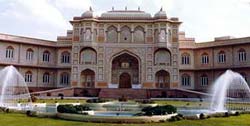 Amer Palace and Shila Mata Temple : A beautiful complex of palaces, halls,pavilions,gardens and temples built by Raja Man Singh,Mirza Raja Jai Singh and Sawai Jai Singh over a period of about two centuries still stand in magnificent state. The palace complex emerges dramatically from the placid waters of the Maotha Lake and is approachable only through a steep path. Tourists often ride on the elephant bak to the Singh pol and th Jaleb Chowk. Two flights of stairs rise from on end of the chowk, one leading to the Shila Mata Temple and other to the palace complex. The image of the patron of goddess,worshipped by thousands of deovtees, was brought from Jessore in East Bengal (now in Bangladesh) by Raja Man Singh, to be installed here.
Amer Palace and Shila Mata Temple : A beautiful complex of palaces, halls,pavilions,gardens and temples built by Raja Man Singh,Mirza Raja Jai Singh and Sawai Jai Singh over a period of about two centuries still stand in magnificent state. The palace complex emerges dramatically from the placid waters of the Maotha Lake and is approachable only through a steep path. Tourists often ride on the elephant bak to the Singh pol and th Jaleb Chowk. Two flights of stairs rise from on end of the chowk, one leading to the Shila Mata Temple and other to the palace complex. The image of the patron of goddess,worshipped by thousands of deovtees, was brought from Jessore in East Bengal (now in Bangladesh) by Raja Man Singh, to be installed here.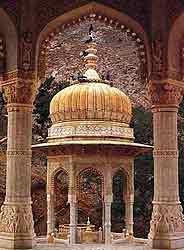
A spectacular pillared hall -Diwan-e-Aam and a double storeyed painted gateway. Ganesh Pole dominate the from courtyard, An elegant tiny garden in Charbagh style beyond th corridors, has Sukh Niws to its right and Jas Mandir to its justify. The latter combines the Mughal and Rajput architecture seen in its beautiful interior with intricately carved Jali screens,delicate mirror and stucco work and painted and carved dadoes. The well proportioned Mohan Bari or Kesar Kyari in the centre of the Maotha Lake and the Dilaram Bagh at its north end provides a spectacular view of the palaces above.
Old City : Once a settlement of nobles,craftsmen and common folks, the city of Amer is now in ruins. The remanants of its rich past are the beautifully carved and planned Jagat Shiromani Temple, a Krishna temple associated with Meerabai, an ancient temple of Narsinghji and a magnificent step-well,Panna Mian-ka-kund.
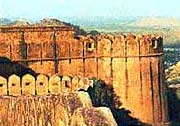 Jaigarh : One of the few military structures of medieval India, retaining its ancient splendour in palaces,gardens , reservoirs, a granary, an armoury, a well planned cannon foundary, several temples, a tall tower and a giant mounted cannon-the Jai Ban,one of the largest in the country are preserved here. The extensive parkotas (wallls), watch tower and gateways of Jaigarh dominate the western skyline.
Jaigarh : One of the few military structures of medieval India, retaining its ancient splendour in palaces,gardens , reservoirs, a granary, an armoury, a well planned cannon foundary, several temples, a tall tower and a giant mounted cannon-the Jai Ban,one of the largest in the country are preserved here. The extensive parkotas (wallls), watch tower and gateways of Jaigarh dominate the western skyline.
 Nahargarh : A sentinerl to the Pink City is Nahargarh Fort, situtated beyond the hills of Jaigarh. Although much of it is in ruins, the lvoerly building added by Sawai Ram Singh II and Sawai Madho Singh II provides interest to the fort.
Nahargarh : A sentinerl to the Pink City is Nahargarh Fort, situtated beyond the hills of Jaigarh. Although much of it is in ruins, the lvoerly building added by Sawai Ram Singh II and Sawai Madho Singh II provides interest to the fort.
EXCURSIONS
Sanganer (12 km): Located on the Tonk road,. In addition to its ruined palaces, Sanganer has exquisitely carved Jain temples. The town is entered through the ruins of two tripolias (Triple gateways) The town is an important centre for crafts industry and produces some of the finest hand printed textiles from units of block and screen printers. This textile is popular all over the country and abroad.
Bagru (35 km) : On the Ajmer Raod, the ground level fort is still in good shape. It is noted for its hand printed handloom industry using simple techniques. The designs of these handloom are less complicated and are in earth hues.
 Ramgarh Lake (32 km. North east): A huge artificial lake created by constructing a high bund amidst tree covered hills. White the temple of Jamwa Mata and the ruins of the old fort are some of its antiquities, its beautiful landscape,especially during monsoons,makes it an idyllic picnic spot.
Ramgarh Lake (32 km. North east): A huge artificial lake created by constructing a high bund amidst tree covered hills. White the temple of Jamwa Mata and the ruins of the old fort are some of its antiquities, its beautiful landscape,especially during monsoons,makes it an idyllic picnic spot.
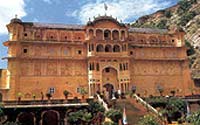 Samod (40 km, north west): The beautiful Samode Palace, has been rebuilt and renovated and provides a fine example of the Rajput haveli architecture and is an ideal spot for outings.
Samod (40 km, north west): The beautiful Samode Palace, has been rebuilt and renovated and provides a fine example of the Rajput haveli architecture and is an ideal spot for outings.
Bairath (86 km on the Shahpura-Alwar Road): An important historical place with the excavated remains of a circular Buddhist temple-unique in Rajasthan and the earliest known temple in India. Bairath also has relics of the Mauryan,Mughal and Rajput periods. A mint constructed by Akbar, a beautiful Mughal garden and a remarkable monument with painted chhatris and walls built by Jahangir are other attractions.
Jaisinghpura Khor (12 km off the Amer Raod) : One of the settlement of the Meena tribe, it has a formidable fort, a jain temple and a step-well amid lush surroundings.